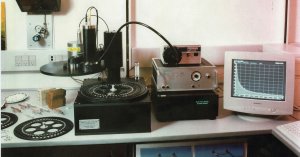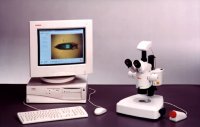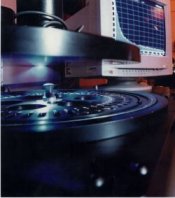Department of Archaeometry
Head: Tsirliganis C. Nestor
Staff:
Postgraduate researchers:
Research assistants: Sakalis Anastasios, Polymeris George, Afouxenidis Dimitrios, Kazakis A. Nikolaos
The Archaeometry department of the Cultural and Educational Technology Institute was founded in 1999 with the objective to function as a technology and research center. With its scientific personnel, specialized facilities and instrumentation it aims at the advancement of scientific research in the field of Archaeometry, and attempts to fulfill the needs of the interested parties in the particular area.
Using the most recent physico-chemical methods, extracts a variety of information from archaeological artifacts, monuments, works of art and materials, resulting to a fuller knowledge and indepth understanding for the advancement of Civilization.
 The Laboratory, in its present
phase of operation, gives special attention to the dating
of ceramics, asbestites, and silicon (quartz) materials,
using TL and OSL methods; authentication of museum and
collection ceramic artifacts, using radiometric techniques
and comparative composition analysis; and the investigation
of the composition of color materials.
The Laboratory, in its present
phase of operation, gives special attention to the dating
of ceramics, asbestites, and silicon (quartz) materials,
using TL and OSL methods; authentication of museum and
collection ceramic artifacts, using radiometric techniques
and comparative composition analysis; and the investigation
of the composition of color materials.
In parallel, the Laboratory, aims to educate and train young
scientists from various disciplines through seminars, workshops
and inter-disciplinarian lectures on Archaeological and Archaeometric
topics.

 The Laboratory has a substantial scientific and technical
state-of-the-art infrastructure and it is technologically
supported by the other sectors of the Cultural and Educational
Technology Institute. Its capabilities are greatly enhanced
through its close co-operation with relevant laboratories
of the Democritus University of Thrace and the Aristotle University
of Thessaloniki.
The Laboratory has a substantial scientific and technical
state-of-the-art infrastructure and it is technologically
supported by the other sectors of the Cultural and Educational
Technology Institute. Its capabilities are greatly enhanced
through its close co-operation with relevant laboratories
of the Democritus University of Thrace and the Aristotle University
of Thessaloniki.
Among the available laboratory facilities are: a fully equipped Thermoluminescence (TL) and Optically Stimulated Luminescence laboratory with state-of-the-art measuring systems, an autonomous, closed x-ray radiography system and a portable x-ray fluorescence (XRF) system, a stereoscope equipped with the necessary hardware and software for digital imaging, image analysis and surface analysis, a fully equipped laboratory for sample preparation and pre-processing involving new-technology laboratory ovens, furnaces and microwave sample digestion systems.
 The Laboratory has the capability to provide specialized
services (dating, stoichiometric chemical analyses, radiographic
and multi-spectral object imaging, in-situ stoichiometric
analyses with radiometric methods, etc) to the scientific
community and various production sectors of the Economy, both
Greek and international (universities, technology institutes,
archaeological agencies, local authorities, enterprises, industry,
individuals etc). All laboratory procedures follow the GLP
and ISO protocols in order to assure high quality services
and absolutely reliable results.
The Laboratory has the capability to provide specialized
services (dating, stoichiometric chemical analyses, radiographic
and multi-spectral object imaging, in-situ stoichiometric
analyses with radiometric methods, etc) to the scientific
community and various production sectors of the Economy, both
Greek and international (universities, technology institutes,
archaeological agencies, local authorities, enterprises, industry,
individuals etc). All laboratory procedures follow the GLP
and ISO protocols in order to assure high quality services
and absolutely reliable results.
In order to achieve its purpose, take full advantage of its capabilities and maximize the quality of the provided services, the Laboratory promotes and sustains collaborations with the interested parties and similar research centers and university departments interested in cognate fields, both in Greece and worldwide.
The main ambition of the Laboratory is its recognition as a specialized national technological center supporting the archaeological research, and its evolution to an internationally distinguished Archaeometry Laboratory renowned for the validity and reliability of its work and results.












